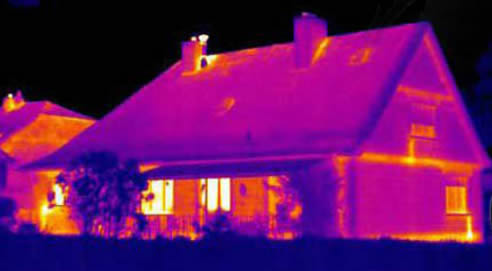NEWS ARTICLE ARCHIVES
Thermal Imaging Can Save on Power from Flir Systems Australia

FLIR thermal imagers can cut power bills
Because FLIR thermal imaging cameras measure heat, the infrared technology can be used to measure the temperature differences in your home or office - and cut your power bills.
FLIR Systems, the global leader in infrared technology, says measuring heat is the easiest and quickest non-destructive method of detecting energy waste, moisture intrusion and electrical issues in buildings and pinpointing where the problems are.
"Once the issues are identified such as faulty insulation or ill-fitting windows - which add enormously to household power bills by allowing heat to escape - most can be quickly remedied and consumers will immediately see the benefit with reduced power bills," said FLIR Systems Managing Director Roger Christiansz.
During the past three years, electricity prices have risen by an average of 35 per cent across Australia. And there is more to come, with estimates that average national prices will jump a further 37 per cent by 2014.
Numerous factors are at work pushing power prices up including a raft of new green costs, including the new carbon tax, a lack of investment in electricity infrastructure in past decades, inefficient power networks and rising fossil fuel prices.
Around the home inspections with a FLIR
FLIR infrared cameras go to work both on the inside and outside of a building and will highlight differences in surface temperature warranting further investigation.
Other common uses for thermal imaging around the house include:
- heating & floor heating inspections
- building envelope thermography
- air tightness testing
- door & window seal inspection
- wall seal heat loss inspection
- roof & wall moisture inspection
- dew point inspection
Blair Freeman, Managing Director Energy Leaks and Certified Building Science Thermographer: "By using our FLIR infrared cameras we are able to detect missing ceiling insulation and gaps throughout the building envelope. Even a 5% gap in your ceiling insulation equates to an overall loss of 40% in your total R values."
A FLIR thermography report on a building can highlight where improvements can be made leading to greater efficiencies and power savings including:
- reducing heating & cooling costs
- detecting and preventing mould and decay
- preventing formation of condensation
- preventing humidity intrusion in building
- increasing the building substance
- checking repair quality
- detecting long-time construction damages
What can you do to minimise your power consumption?
Over and above getting your home made more energy efficient there are lots of small changes you can make that add up to big savings.
The first involves simple steps that you can put in place immediately:
- Getting into the habit of switching off lights when they�re not needed
- Turning off appliances that are not in use, rather than putting them on �standby�
- Reducing home heating and cooling - consider setting the winter thermostat to 20 degrees and the summer one to 27 degrees to save energy and money;
- Reducing heat loss by sealing draughts from windows, doors and even fireplaces
- Planning ahead for hot days by closing windows and blinds to keep out the sun�s heat before it gets to your home
- Fixing leaking taps can save as much as 20,000 litres of water per year
- Taking shorter showers and installing a low-flow showerhead can make a big difference to your water bill
The next level involves more major issues such as the structure and positioning of your home. Remember, when building, the smaller your home the more energy efficient it will be.
- The orientation of your home can make a huge difference to heating and cooling bills. You want to make the most of the sun in winter and have ways to shade the sun in summer
- Insulation should be properly installed and thorough to reduce your home's heating and cooling costs
- The design of your roof makes a difference: a high-pitched roof offers more protection from the sun than a flat roof
- The colour and texture of materials on the roof also impact efficiency: heavy and dark roof tiles should be avoided because they hold more heat and keep the home hot in summer.
Not only will these energy efficiency tips save you a huge amount of money in the running costs of your home, they will also mean you are living in a more environmentally sustainable way.
About thermal imaging
Thermal imaging cameras produce images of invisible infrared or 'heat' radiation. Based on temperature differences between objects, thermal imaging produces a clear image. It is an excellent tool for predictive maintenance, building inspections, research & development and automation applications.
It can see in total darkness, in the darkest of nights, through fog, in the far distance, through smoke. It is also used for security and surveillance, maritime, automotive, firefighting and many other applications.
About FLIR Cameras
FLIR Systems is the world leader in infrared cameras, having the widest range and offering the highest standard of any supplier for predictive and preventative maintenance.
The FLIR range includes:
- The low cost, powerful little revolutionary FLIR i3, producing snapshots of temperature differences equal to 3,600 readouts from a single spotmeter with the i5 and i7 producing even more.
- The ground-breaking FLIR E-Series extends performance and affordability with features like Bluetooth® and industry-first Wi-Fi connectivity, 3.5" touchscreen and iPhone/iPad App. Add to this MeterLink, the pioneering wireless connection from FLIR that connects your infrared camera with your ClampMeter.
- The FLIR T-Series also has MeterLink and offers an optimum mix of ergonomics and flexibility. The T-Series takes the quality of image to a whole new level and has a long list of impressive features, including Bluetooth®, Wi-Fi connectivity, 4.3" touchscreen, iPhone/iPad App and some models with the stunning MSX™ feature.
|
|


